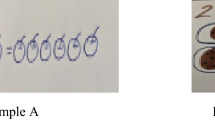Abstract
This article describes a study of how Chinese preservice teachers unpacked a learning goal pertaining to adding fractions and understanding the concepts underlying the operation. Based on work in the USA by Morris, Hiebert, and Spizter (Journal for Research in Mathematics Education, 40(5), 491–529, 2009), 50 Chinese preservice teachers completed a task, anticipating an ideal student response, in the context of four representations: (1) fraction pieces, (2) graph paper, (3) common denominator algorithm, and (4) pennies. Like the US-based study, this study shows that Chinese preservice teachers’ ability to unpack a learning goal was highly influenced by how the problem was represented. The pennies and graph paper problems provided more supportive contexts for unpacking the learning goal; the algorithm problem provided the least supportive context. The main difference between the preservice teachers from these two countries was the US preservice teachers chose the pennies and graph paper problems as having the most potential for revealing students’ understanding of the learning goal; while the Chinese preservice teachers chose the algorithm problem despite the problem’s unsupportive context. Chinese preservice teachers’ preference suggests that they privileged algorithmic/symbolic representations over pictorial/concrete representations. Based on our results, we argue that it is time for cross-cultural comparative research to refocus on the common barriers, challenges, and benefits as related to mathematics teacher preparation and professional development. A cooperative instead of competitive orientation will lead to richer and deeper dialogues among mathematics educators.

Similar content being viewed by others
References
An, S., Kulm, G. & Wu, Z. (2004). The pedagogical content knowledge of middle school mathematics teachers in China and the US. Journal of Mathematics Teacher Education, 7, 145–172.
Ball, D. L., Thames, M. H. & Phelps, G. (2008). Content knowledge for teaching: What makes it special? Journal of Teacher Education, 59(5), 389–407.
Braun, V. & Clarke, V. (2006). Using thematic analysis in psychology. Qualitative Research in Psychology, 3, 77–101.
Bu, L. (2013). Why is the midpoint an average? Mathematics Teacher, 106(7), 514–519.
Cai, J. (2000). Mathematical thinking involved in U.S. and Chinese students’ solving process-constraint and process-open problems. Mathematical Thinking and Learning: An International Journal, 2, 309–340.
Cai, J. (2001). Improving mathematics learning: Lessons from cross-national studies of Chinese and U. S. students. Phi Delta Kappan, 82(5), 400–404.
Cai, J. (2006). U.S. and Chinese teachers’ cultural values of representations in mathematics education. In F. K. S. Leung, K. D. Graf & F. J. Lopez-Real (Eds.), Mathematics education in different cultural traditions: A comparative study of East Asia and the West: The 13th ICMI Study (pp. 465–481). New York, NY: Springer.
Cai, J. & Cifarelli, V. (2004). Thinking mathematically by Chinese learners: An international comparative perspective. In L. Fan, N.-Y. Wong, J. Cai & S. Li (Eds.), How Chinese learn mathematics: Perspectives from insiders (pp. 71–106). Singapore: World Scientific Publishers.
Cai, J. & Lester, F. K., Jr. (2005). Solution representations and pedagogical representations in Chinese and U.S. classrooms. Journal of Mathematical Behavior, 24, 221–237.
Cleaves, W. P. (2008). Promoting mathematics accessibility through multiple representations jigsaws. Mathematics Teaching in the Middle School, 13(8), 446–452.
Flevares, L. M. & Perry, M. (2001). How many do you see? The use of nonspoken representations in first-grade mathematics lessons. Journal of Educational Psychology, 93(2), 130–145.
Jacobs, V. R., Lamb, L. C. & Philipp, R. A. (2010). Professional noticing of children’s mathematical thinking. Journal for Research in Mathematics Education, 41(2), 169–202.
Jansen, A., Bartell, T. & Berk, D. (2009). The role of learning goals in building a knowledge base for elementary mathematics teacher education. The Elementary School Journal, 109(5), 525–536.
Kinach, B. M. (2002). Understanding and learning-to-explain by representing mathematics: epistemological dilemmas facing teacher educators in the secondary mathematics “methods” course. Journal of Mathematics Teacher Education, 5(2), 153–186.
Kirwan, V. J. & Tobias, J. M. (2014). Multiple representations and connections with the Sierpinski triangle. Mathematics Teacher, 107(9), 666–71.
Leung, F. K. S. (2006). Mathematics education in East Asia and the West: Does culture matter? In F. K. S. Leung, K. D. Graf & F. J. Lopez-Real (Eds.), Mathematics education in different cultural traditions: A comparative study of East Asia and the West: The 13th ICMI Study (pp. 21–46). New York, NY: Springer.
Leung, F. K. S. & Park, K. (2002). Competent students, competent teachers? International Journal of Educational Research, 37, 113–119.
Ma, L. (1999). Knowing and teaching elementary mathematics: Teachers’ understanding of fundamental mathematics in China and the United States. Mahwah, NJ: Lawrence Erlbaum Associates.
Morris, A. K., Hiebert, J. & Spitzer, S. M. (2009). Mathematical knowledge for teaching in planning and evaluating instruction: What can preservice teacher learn ? Journal for Research in Mathematics Education, 40(5), 491–529.
Shulman, L. (1986). Those who understand: Knowledge growth in teaching. Educational Researcher, 15, 4–14.
Stevenson, H. W. & Stigler, J. W. (1992). The learning gap: Why our schools are failing and what we can learn from Japanese and Chinese education. New York, NY: Summit Books.
Stigler, J. W. & Hiebert, J. (2004). Improving mathematics teaching. Educational Leadership, 61(5), 12–17.
Stigler, J. W. & Perry, M. (1988). Cross-cultural studies of mathematics teaching and learning: Recent findings and new directions. In D. Grouws & T. Cooney (Eds.), Effective mathematics teaching directions (pp. 194–223). Reston, VA: National Council of Teachers of Mathematics.
Strauss, A. & Corbin, J. (1998). Basics of qualitative research: Techniques and procedures for developing grounded theory. Thousand Oaks, CA: Sage Publications.
Wang, J. & Lin, E. (2005). Comparative studies on U.S. and Chinese mathematics learning and the implications for standards-based mathematics teaching reform. Educational Researcher, 34(5), 3–13.
Zhang, H. & Zhou, Y. (2003). The teaching of mathematics in Chinese elementary schools. International Journal of Psychology, 38(5), 286–298.
Author information
Authors and Affiliations
Corresponding author
Rights and permissions
About this article
Cite this article
Kang, R., Liu, D. The Importance of Multiple Representations of Mathematical Problems: Evidence from Chinese Preservice Elementary Teachers’ Analysis of a Learning Goal. Int J of Sci and Math Educ 16, 125–143 (2018). https://doi.org/10.1007/s10763-016-9760-8
Received:
Accepted:
Published:
Issue Date:
DOI: https://doi.org/10.1007/s10763-016-9760-8




